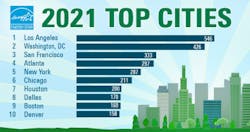EPA Names 2021 Top Cities for ENERGY STAR Certified Buildings
PRESS RELEASE
WASHINGTON (June 2021) — The U.S. Environmental Protection Agency (EPA) has announced its annual “Top Cities” list, spotlighting the cities with the largest number of ENERGY STAR-certified commercial and multifamily buildings last year. Los Angeles leads the pack, with more than 580 ENERGY STAR certified buildings. Close behind is Washington, D.C., with nearly 550 buildings, followed by San Francisco in third place. Atlanta and New York round out the top five.
“Cities and communities play an essential role in reducing energy use in commercial and multifamily buildings,” said EPA Administrator Michael S. Regan. "With help from ENERGY STAR, city leaders and building owners are working together to strengthen their economies and reduce the emissions that lead to climate change.”
“Here in Los Angeles, sustainability isn’t just a buzzword we throw around lightly — it’s a lens through which we see every policy decision,” said LA Mayor Eric Garcetti. “Year in and year out, Los Angeles finds itself at the head of the pack when it comes to energy efficiency — showing the world that going green is good for your bottom line.”
Commercial buildings are responsible for 18 percent of the nation’s energy use and cost more than $190 billion per year in energy bills. ENERGY STAR certified buildings use an average of 35 percent less energy and are responsible for 35 percent less carbon dioxide emissions than typical buildings.
First released in 2009, EPA’s list of cities with the most ENERGY STAR certified buildings shows how buildings across America are embracing energy efficiency as a simple and effective way to save money and reduce greenhouse gas emissions. To create the annual list, EPA tallies the number of ENERGY STAR certified buildings within each metropolitan area, as defined by the U.S. Census. These areas include the city itself as well as surrounding suburbs.
This year’s Top Cities are:
- To view the rest of the Top 25, click here.
Across the country, nearly 6,500 commercial buildings earned the ENERGY STAR last year.
As of the end of 2020, over the lifetime of the program more than 37,000 buildings across America had earned EPA’s ENERGY STAR certification. Together, these buildings have saved more than $5 billion on energy bills and prevented nearly 22 metric tons of greenhouse gas emissions—equal to the annual emissions of more than 2.6 million homes.
To earn EPA’s ENERGY STAR, a commercial building must earn an ENERGY STAR score of 75 or higher on EPA’s 1 – 100 scale, indicating that it is more energy efficient than 75 percent of similar buildings nationwide. When calculating a building’s ENERGY STAR score, ENERGY STAR takes into account multiple factors, including hours of operation, energy use, and occupancy. This means that, despite buildings operating differently during the COVID pandemic, ENERGY STAR scores and certification still reflect actual, measured energy efficiency.
About ENERGY STAR
ENERGY STAR® is the government-backed symbol for energy efficiency, providing simple, credible, and unbiased information that consumers and businesses rely on to make well-informed decisions. Thousands of industrial, commercial, utility, state, and local organizations—including nearly 40 percent of Fortune 500®—rely on their partnership with EPA to deliver cost-saving energy efficiency solutions. Together, since 1992, ENERGY STAR and its partners have helped American families and businesses save 5 trillion kilowatt-hours of electricity, avoid more than $450 billion in energy costs, and achieve 4 billion metric tons of greenhouse gas reductions, all through voluntary action. Learn more about ENERGY STAR at https://www.energystar.gov/about
More on ENERGY STAR Top Cities, including the 2021 ranking of top small and mid-sized cities, as well as last year’s rankings: https://www.energystar.gov/buildings/about_us/newsroom/2021_top_cities
Search for ENERGY STAR certified buildings: https://www.energystar.gov/buildings/reference/find-energy-star-certified-buildings-and-plants/registry-energy-star-certified-buildingsMore about earning the ENERGY STAR certification for commercial buildings: https://www.energystar.gov/buildings/building_recognition/building_certification

